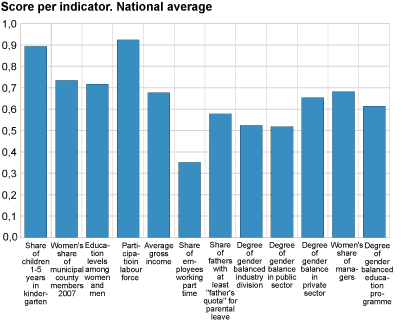Content
Published:
This is an archived release.
Regional differences in gender equality
The municipalities with least equality are mainly found in the Southern and Western part of Norway. In addition to Sogn og Fjordane, Troms and Finnmark, the municipalities with the most gender equality are found mainly in the Eastern and Central part of the country. All of the six largest towns and cities - Oslo, Kristiansand, Stavanger, Bergen, Trondheim and Tromsø - are among the municipalities with most equality.
Since 1999, Statistics Norway has published an index on gender equality in all 430 Norwegian municipalities. The index was changed in 2009, including more indicators and a more composite method.
Score intervalsGender equality can be measured in different ways. The new index on gender equality in the municipalities is thus only one of several possible variants. An index is a collection of measurements that simplifies data and makes it easier to compare municipalities with regard to a number of indicators. Designing an index aimed at measuring gender equality entails making a number of choices, both with regard to content in the indicators and how these are assembled. The differences between some municipalities when it comes to gender equality may be very slight The municipalities are therefore grouped into four groups, according to how they are categorised in terms of equality: The 2010 index places the municipalities in the following quarter groups by level of equality: The lowest level of equality: Score interval 0,534-0,646 The second lowest level of equality: Score interval 0,647-0,674 The second highest level of equality: Score interval 0,675-0,699 The highest level of equality: Score interval 0,700-0,793 For more information about the indicators, data source and method, see About the statistics and Note 2009/65 (in Norwegian only). |
The gender equality index 2010
When the municipalities are grouped into four equal groups by degree of equality, some regional patterns can be seen (see map).
The municipalities with least equality are found in the Vest-Agder, Aust-Agder, Rogaland, Hordaland and Møre og Romsdal. A total of 71 of the 100 least equal municipalities are found in these five counties. The municipalities with most equality are mainly found in the central and inland area of Eastern Norway (Oslo, Akershus, Hedmark, Oppland and Buskerud). Many municipalities with the most equality are also found in the municipalities of Troms, Finnmark and Sogn og Fjordane.
Least equality in Southern and Western Norway
The main pattern for the municipalities with the least equality in the Southern and Western part of the country is a high degree of income disparities, a high share of women in part time work, few female leaders and a skewed distribution of municipal council representatives. The uneven distribution of men and women in the private and public sectors with regard to the workplace is also a general feature of the municipalities with the least equality.
Eastern Norway, Sogn og Fjordane and Northern Norway the most equal
When the municipalities that are categorised as having the most equality are considered, there are some differences between those in the north, west and east. Many municipalities in Akershus are distinguished by having a more gender-balanced structure in industry (i.e. relatively many employees work in an industry that is gender-balanced) There is also a more even balance in the private sector between men and women in these municipalities, while in the north the private sector is more male-dominated.
With regard to income disparities, it is a general feature throughout Finnmark that there is little or no difference between men and women. All 19 municipalities in Finnmark are among the quarter of municipalities with the least difference between men and women’s income. It can be worth noting that the general level of income among men in Finnmark is consistently lower than for men in other municipalities.
The municipalities with most equality in Sogn og Fjordane stand out in comparison with the other municipalities with equality as having a particularly high share of fathers taking the statutory paternity leave or more of the parental leave in connection with childbirth.
High degree of equality in the largest municipalities
All of the six largest towns and cities - Oslo, Kristiansand, Stavanger, Bergen, Trondheim and Tromsø - are among the municipalities with most equality, and consistently score high on most indicators despite there being some variation. For other indicators, however, these cities lie below the average. In Oslo and Stavanger a smaller share of children aged 1-5 years go to kindergarten than is the case for half of the municipalities. Oslo stands out as having a lower share of fathers taking statutory paternity leave or more. Kristiansand and Stavanger both lie below the average for participation in the labour force and income (there are thus greater differences between men and women's participation in the labour force and income than among the half of the municipalities with least differences). Kristiansand, Stavanger, Bergen and Trondheim all have a lower share of female managers than in most other municipalities. Oslo and Tromsø are the only places that score relatively high on this indicator.
We can also see which indicators contribute the most to the level of equality in the cities, and for the country as a whole. While part-time work, low level of women’s income, and few women leaders on average contribute to a low score on the index, the share of children in kindergarten and participation in the labour force for most municipalities contribute to a high score.
Tables:
Additional information
The indicators of gender equality in municipalities has been published every year since 2008. The indicators are based on available statistics from registers, and measure gender equality in all municipalities and counties, as well as average for the whole country.


